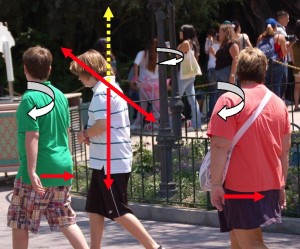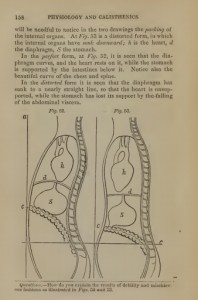 We have a “Structure First” approach to fitness at The Lean Berets due to our historical studies about the history of fitness. When studying classical physical education, one cannot deny the importance of structural integrity–or simply put–posture. Our children are not taught posture in school anymore. Adults rarely discuss posture unless they are old enough to remember it in school pre-1970s. *In the photo above, the child in green has severe internal rotation of the shoulders from poor posture. Palms should be facing sides of legs–not behind body. The same internal rotation is found on the woman to rear. The child in white has extreme forward head position and rounded thoracic spine predisposing him to decades of pain and injury. All this is “created” because we do not teach proper posture and structure–and we sit more than move of course.
We have a “Structure First” approach to fitness at The Lean Berets due to our historical studies about the history of fitness. When studying classical physical education, one cannot deny the importance of structural integrity–or simply put–posture. Our children are not taught posture in school anymore. Adults rarely discuss posture unless they are old enough to remember it in school pre-1970s. *In the photo above, the child in green has severe internal rotation of the shoulders from poor posture. Palms should be facing sides of legs–not behind body. The same internal rotation is found on the woman to rear. The child in white has extreme forward head position and rounded thoracic spine predisposing him to decades of pain and injury. All this is “created” because we do not teach proper posture and structure–and we sit more than move of course.
If we are to move well, we must start teaching good posture. The idea of playing sports or moving around quickly without addressing postural structure is out of balance. First things first–posture, structure, line, or whatever term you want to call it, but we had better get ourselves upright and set properly to reduce pain and injury and begin moving well again.
Here are the primary issues:
- Seat Angle: Should be 60 degrees.
- Seat Height: Should be low enough for feet to touch floor.
- Desktop Angle: Should be as close to 22 degrees as possible.
- Desktop Height: Should be slightly lower than elbows to prevent raising shoulders while working.
- Sit VS. Stand? There is more compressive force on your spine while sitting than standing; therefore, if you have a “Sit-Stand” Workstation option, this would be ideal so you can go from a proper seat position like above to full standing. Also, standing while working on computer also requires more muscular work, so while small, you are getting some added movement throughout the day as you shift back and forth on feet, etc. Standing all day is not the best solution; the option to go from seated to standing then taking regular breaks for postural resets would be more helpful in our opinion.
For more information, attend one of our “Posture” Workshops. Additionally, the following resources will be also helpful to justify attention to posture–especially for parents with young children.
Handouts & Articles: Simple supportive materials to justify the importance of posture and how poor posture ruins our structure.
- Balanced Sitting (A.C. Mandal, MD)
- Children of Clay (Dr. Ed Thomas)
- The Coordinated Classroom (Dr. Darell Harmon)
- Postural Deformities (IHPRA)
- School Furniture (IHPRA)
- Effectiveness of Disc-O-Sit Cushions on Attention to Task (PubMed)
Posture Products: (To Assist Decompression of Spine)
- Disc-O-Sit (Youth-Preserves Neutral Spine)
- Disc-O-Sit (Adult-Preserves Neutral Spine)
- Inversion Tables (Spinal Decompression & Other Benefits)
- Inversion Boots (Spinal Decompression & Other Benefits)
- Reading Lap Pillow (Optimizes C-Spine Position & Reading Performance)
- Reading Slant Board (Optimizes C-Spine Position & Reading Performance)
Inversion: Hippocrates used inversion along with thousands throughout history for enhancing health and decompressing the spine.
Lean Berets Videos: Stay tuned as we are developing many good videos and resources for posture and structure education that can be used for work, home, and school.
Education Videos: Much of the best in American physical education begins in Iowa then moves across the country. Current Physical Education is a great example of how Iowa is setting new trends based on sound historical methods–with posture and structure first. Other educational videos related to posture and slant boards also listed.
